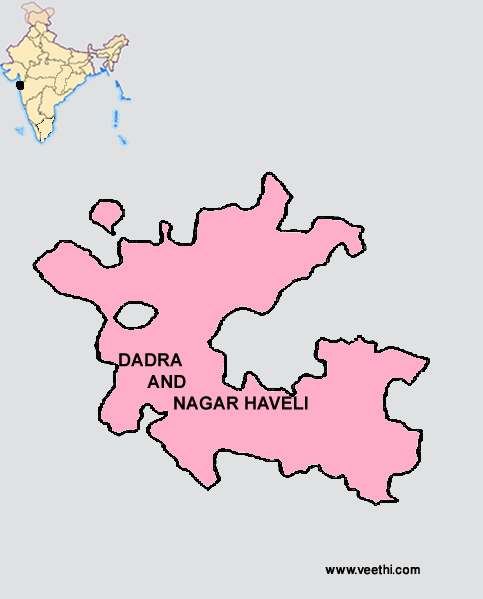Dadra and Nagar Haveli is a Union Territory of India. The capital of Dadra and Nagar Haveli is Silvassa. It lies in the watershed region of Daman Ganga River. Dadra lies to the north of Nagar Haveli in Gujarat.
History of Dadra and Nagar Haveli
Dadra and Nagar Haveli was ruled by Koli chiefs and the kings of Jawhar and Ramnagar defeated them. It was under the control of Rajputs until 18th century and then it came under the rule of Marathas. In 1779, Portuguese were allowed to collect revenue from the 79 villages here by the Maratha Peshwa. They occupied Nagar Haveli on 10th June 1783 and in 1785 they purchased Dadra also.
On 2nd August 1954, it was liberated from the Portuguese rule and Varishta Panchayat of Free Dadra and Nagar Haveli was formed to govern the area. In 1961, it was formally merged into the Indian Union and made as a Union Territory according to the treaty signed by the Prime Minister of Dadra and Nagar Haveli, Mr. Badlani.
Geography of Dadra and Nagar Haveli
Dadra and Nagar Haveli spreads over an area of 491 square kilometers. It is surrounded by Sahyadri Mountains of Western Ghats. Daman Ganga River flows through this region and drains in the Arabian Sea. 20,359 hectares of land in this territory is covered by reserve forests. The land is rich and fertile and has rich biodiversity.
The climate in Dadra and Nagar Haveli is warm and humid in summer season. The winters are mild and pleasant and from June to September it gets its rainfall from southwest monsoon winds. The average annual rainfall ranges from 2500 mm to 3000 mm.
Districts of Dadra and Nagar Haveli
Dadra and Nagar Haveli is not divided into districts but into two taluks.
|
Taluks |
Headquarters |
Villages |
|
Dadra |
Dadra town and 2 villages |
|
|
Silvassa town and 68 villages |
Map of Dadra and Nagar Haveli

People and Culture of Dadra and Nagar Haveli
Dadra and Nagar Haveli has a population of 342,853 people as per the census of 2011 with a density of 698 people per square kilometers. The growth rate of the population is 55.5% and this is highest percentage growth among other states of India. It has a sex ratio of 775 females for every 1000 males.

62% of the people belong to one of the tribal groups namely Dhodia, Kokna, Valir, Koli, Kathodi, Naika and Dubla. These people worship Sun God and Moon God named Dis and Chand and other deities are Narandev, kanasari, Himai, Hirva, Rangtai, Vagdev and Veer. People of other language groups such as Gujaratis, Rajasthanis, Biharis, Tamilians and Uttar Pradeshis also live here. The three official languages of Dadra and Nagar Haveli are English, Gujarati and Hindi.
Varli tribes wear small waist coat and turban and women wear saree and metal ornaments. Dhodia tribes wear colorful bead necklaces and bangles. Koknas are well built people and have tattoos on their bodies and foreheads. Kathodias are primarily woodcutters. Dublas are engaged in agriculture.
All the major festivals of Hindus, Muslims and Christians are celebrated here and apart from them, Diwaso is celebrated by Dhodia and Varli tribes, Raksha Bandhan by Dhodia tribes, Bhawada by Varli and Koli tribes and Khali Puja by all of them after every crop harvest.
Economy of Dadra and Nagar Haveli
The GSDP of 2004 was $218 million rupees and in 2009 it increased to $360 million rupees. The per capita GDP in 2009 was $1050. Many manufacturing industries are located here due to low taxation in the area. Dan Udyog Sahakari Sangh Ltd was the pioneer in improving the industrial sector of the territory. This led to the growth of more than 1600 small scale industrial units and 430 medium scale industries that produce textiles, engineering goods, plastics, electronics, pharmaceuticals and chemicals. More than 43,100 people are employed in these units.
Education in Dadra and Nagar Haveli
Dadra and Nagar Haveli is still lagging behind other Indian states in its education. The literacy ratio of people in 2011 was 77.65%. In 1991 it was only 41% and in 2001 it increased to 60.03%. In 1983-84 there were only 13 pre-primary schools in the region with 562 children totally. However with the efforts of the government by 2000 the number of schools increased to 215. Compulsory and free education is provided to all students with free midday meals and books. SSR College of Education, SSR College of Pharmacy, SSR College of Arts, Commerce and Science are some of the colleges situated here.
Dadra and Nagar Haveli Transportation
Dadra and Nagar Haveli has a total road length of 342 kilometers. It does not have its own road transport system and it uses the transport system of Gujarat and Maharashtra. The nearest airport is Bombay. The nearest railways station is Vapi which is located 18 kilometers from Silvassa.
Dadra and Nagar Haveli Tourism
Dadra and Nagar Haveli is a good place for ecotourism as it is rich in biodiversity. Also there are some beautiful places here that are worth visiting. Some of the places of interest in Dadra and Nagar Haveli are listed below.
1. Vanganga Lake Garden
2. Hirwavan Garden at Piparia
3. Tribal Museum at Silvassa
4. Vanvihar Tourist Complex at Chauda
5. Tapovan Tourist Complex at Bindrabin
6. Water Sports Center at Dudhani
7. Mini Zoo and Bal Udhyan at Silvassa
8. Vandhara Udyan at Silvassa






















.jpeg)